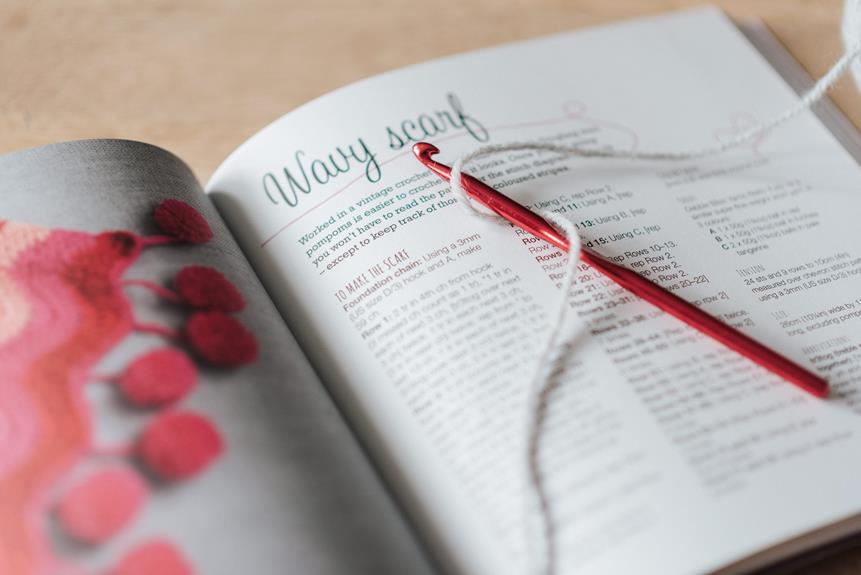Want to add a personal touch to your fabric projects? Did you know that 87% of crafters enjoy customizing their fabrics with unique designs? Learning how to transfer paper designs onto fabric opens up a world of creative possibilities.
From heat transfer pens to freezer paper stencils, there are various techniques to master. You'll explore the art of choosing the right paper designs and preparing the fabric surface for a flawless transfer.
By using iron-on transfers or heat transfer pens, you can bring your paper designs to life on fabric. Finish off with some tips on caring for your transferred designs, and you'll be well on your way to mastering this valuable skill for your crafting repertoire.
Key Takeaways
- Choose bold and simple paper designs that have clear, distinct lines
- Consider the quality, thickness, and compatibility of the paper and fabric
- Explore different methods such as using heat transfer pens, iron-on transfers, and freezer paper stencils
- Select the appropriate transfer paper type and follow proper care instructions for successful and long-lasting results
Choosing the Right Paper Designs
Choose a few simple and bold paper designs that will transfer well onto fabric for the best results.
When selecting paper designs for fabric transfer, it's crucial to consider the paper quality and design compatibility. Opt for high-quality paper that isn't too thin, as it needs to withstand the transfer process without tearing or disintegrating. Look for designs that have clear, distinct lines and minimal intricate details, as these will transfer more accurately onto fabric.
Bold, large designs with well-defined edges tend to work best, ensuring that the transferred image onto the fabric is crisp and easily recognizable. Avoid designs with too many fine lines or intricate patterns, as these may not translate well onto the fabric and can result in a messy or unclear transfer.
Additionally, consider the color of the design, as it should complement the fabric color for the best visual impact. By carefully selecting paper designs with the right quality and compatibility, you can ensure successful and professional-looking transfers onto fabric.
Using Heat Transfer Pens
You can use heat transfer pens to effortlessly transfer your chosen paper designs onto fabric. Here are some techniques and best practices for using heat transfer pens:
- Choose the Right Fabric: Opt for a fabric that can withstand the heat required for the transfer process, such as cotton or linen. Pre-wash the fabric to remove any sizing or chemicals that may interfere with the transfer.
- Prepare Your Design: Trace or draw your design onto the tracing paper using the heat transfer pen. Ensure that the design is the mirror image of how you want it to appear on the fabric.
- Transfer the Design: Place the traced side of the paper onto the fabric, then apply heat using an iron or heat press. Follow the instructions provided with the heat transfer pen for the recommended temperature and duration.
- Heat Transfer Troubleshooting: If the transfer is incomplete, apply more heat and pressure. If the design smudges, allow it to cool completely before attempting to fix it. If you encounter difficulties, consider alternative methods such as using transfer pencils or sheets.
Using these techniques and best practices will help you achieve crisp and durable transfers onto your fabric.
Exploring Iron-On Transfers
Exploring iron-on transfers enhances the versatility of transferring paper designs onto fabric, allowing for greater creative possibilities. When working with iron-on transfers, it's important to consider the different types of fabric and tailor your techniques accordingly. Here are some iron-on transfer techniques and troubleshooting tips to help you achieve the best results.
| Iron-On Transfer Techniques | Types of Fabric Considerations | Troubleshooting Tips |
|---|---|---|
| Preparing the fabric by washing and ironing to remove any wrinkles or debris. | Cotton and linen tend to work well with iron-on transfers due to their smooth texture. | Ensure that the iron is set to the correct temperature and apply even pressure when ironing. |
| Printing the design onto transfer paper using a high-quality printer for optimal results. | Synthetic fabrics like polyester may require a lower heat setting to prevent scorching or melting. | If the transfer does not adhere properly, reapply heat and pressure, making sure to cover the entire design. |
| Carefully trimming the excess transfer paper around the design to avoid any unwanted residue on the fabric. | Avoid using iron-on transfers on delicate fabrics such as silk, as they may not withstand the heat required for the transfer process. | Test the transfer on a scrap piece of fabric before applying it to your final project to avoid any mishaps. |
Creating Freezer Paper Stencils
After mastering the iron-on transfer techniques discussed in the previous subtopic, expand your fabric design repertoire by delving into the art of creating freezer paper stencils. This versatile method allows you to achieve intricate and personalized designs on fabric with ease.
- Stencil cutting: Begin by sketching your design onto the matte side of the freezer paper. Use a sharp craft knife to carefully cut out the design, creating a stencil that will be used to transfer the design onto the fabric.
- Design placement: Once your stencil is ready, position it on the fabric and use a hot iron to adhere the shiny side of the freezer paper to the fabric. Make sure to press firmly to ensure that the stencil is securely attached.
- Paint application: With the stencil in place, apply fabric paint using a stencil brush or sponge. Take care to dab the paint gently to prevent bleeding and maintain sharp lines.
- Peeling off the stencil: After the paint has dried, gently peel off the freezer paper stencil to reveal your beautifully transferred design.
Mastering the art of freezer paper stencils opens up endless possibilities for creating custom fabric designs.
Preparing the Fabric Surface
Before transferring your paper designs onto fabric, it's important to prepare the fabric surface.
First, choose a suitable fabric that will hold the design well.
Next, pre-wash the fabric to ensure it's smooth and free from any shrinkage that could distort the design.
Choosing Suitable Fabric
To prepare the fabric surface for transferring paper designs, select a suitable fabric that has a smooth and even texture. When choosing fabric for transferring paper designs, consider the following:
- Cotton: Opt for 100% cotton fabric for a versatile and easy-to-work-with option.
- Linen: Choose linen for a slightly textured surface that adds a rustic charm to your designs.
- Silk: Select silk for a luxurious and smooth surface that works well for intricate designs.
- Polyester blends: Consider polyester blends for a budget-friendly option with minimal wrinkling and easy care.
Remember to consider the fabric color options as well to ensure that your transferred designs stand out effectively. Look for fabrics that complement the colors and style of your paper designs for a cohesive and professional result.
Pre-Washing for Smoothness
Once you have selected your fabric, it's important to pre-wash it to ensure a smooth and even surface for transferring paper designs. Pre-washing helps to remove any residual chemicals, dirt, or sizing from the fabric, which can interfere with the transfer process.
When pre-washing your fabric, be sure to follow the washing techniques recommended for the specific type of fabric you're using. For natural fibers like cotton or linen, a gentle machine wash with mild detergent is often suitable. However, for delicate fabrics like silk, hand washing in cold water may be more appropriate.
After washing, air-dry the fabric or tumble dry on low heat, and then iron it to remove any wrinkles. This fabric preparation step is crucial for achieving a flawless transfer of paper designs onto fabric.
Applying the Transfer Method
Now that you've prepped your fabric, it's time to consider the transfer method.
First, you'll need to choose the right transfer paper for your project.
Then, you can explore using heat transfer methods to transfer your design onto the fabric.
And finally, you might be wondering if the transferred design will wash out – we'll cover that too.
Choosing Transfer Paper Types
Start by selecting the appropriate transfer paper type for your fabric project. Consider the following options:
- Inkjet Transfer Paper: Ideal for light-colored fabrics and offers good durability for washability.
- Laser Transfer Paper: Suitable for dark-colored fabrics and provides excellent durability for long-lasting designs.
- Sublimation Transfer Paper: Works well for polyester fabrics and offers vibrant, high-quality results with heat transfer techniques.
- Vinyl Transfer Paper: Perfect for creating intricate designs and patterns on fabric, especially for heat transfer techniques.
Each transfer paper type has specific attributes that cater to different fabric types and design requirements. By choosing the right transfer paper, you can ensure that your designs adhere effectively and maintain their quality through washes and wear.
Using Heat Transfer
To successfully transfer your design onto fabric, begin by using heat transfer to apply the chosen transfer paper onto the fabric. When using heat transfer techniques, it's crucial to ensure that the transfer paper quality is top-notch.
Start by preheating your iron to the appropriate temperature recommended for the specific transfer paper being used. Place the transfer paper onto the fabric with the design facing down. Apply firm and even pressure with the preheated iron, moving it in a circular motion to ensure the entire design is properly transferred. Pay attention to the corners and edges to prevent incomplete transfers.
Once the transfer process is complete, allow the fabric to cool before carefully peeling off the transfer paper. Following these heat transfer techniques and using high-quality transfer paper will result in a crisp and durable design on your fabric.
Will It Wash Out?
After using heat transfer to apply the transfer paper onto the fabric, you may wonder if the design will wash out with regular use and laundering. Here's what you need to know to ensure the longevity of your transferred designs:
- Follow Care Instructions: Always follow the care instructions provided with the transfer paper. Different types of transfer paper may require specific washing and drying methods to maintain the design's integrity.
- Use Mild Detergent: When laundering fabric with transferred designs, use a mild detergent to prevent the design from fading or washing out prematurely.
- Turn Garments Inside Out: To protect the design, turn garments inside out before laundering to reduce friction and minimize direct contact with other items in the wash.
- Avoid High Heat: When drying, avoid high heat settings as excessive heat can cause the design to deteriorate.
Finishing and Caring for Transferred Designs
Here's the adjusted paragraph structure:
Care for transferred designs by gently hand-washing the fabric in cold water and avoiding harsh detergents or bleach.
After transferring your paper design onto fabric, it's crucial to employ caring techniques to preserve the quality of the design. Hand-washing the fabric in cold water is the best way to ensure the longevity of your transferred design. Use a mild detergent specifically formulated for delicate fabrics to gently cleanse the fabric without causing any damage to the transferred design. Avoid harsh scrubbing or wringing, as this can cause the design to fade or distort.
Once washed, gently press the fabric between two towels to remove excess water, and then air-dry it by laying it flat on a clean surface. If ironing is necessary, use a low heat setting without steam, and place a pressing cloth over the transferred design to prevent any direct contact with the iron.
Frequently Asked Questions
Can I Use the Same Heat Transfer Pen for Different Colors of Fabric?
Yes, you can use the same heat transfer pen for different colors of fabric. Just ensure the pen is compatible with the fabric type and follow the instructions for best results. Happy crafting!
How Do I Preserve the Transferred Design When Washing the Fabric?
To preserve the transferred design when washing the fabric, use a heat transfer pen appropriate for different fabric colors. Follow the pen's instructions for setting the design, ensuring it withstands washing.
Can I Use Regular Printer Paper for Iron-On Transfers?
Yes, you can use regular printer paper for iron-on transfers, but it's not the best option. Consider using transfer paper specifically designed for fabric, as it adheres better and is washable.
How Do I Prevent the Design From Smudging or Bleeding Onto the Fabric?
To prevent smudging, make sure the ink is compatible with the fabric. Choose a colorfast ink and avoid touching the design before it's fully dry. And always test the transfer on a scrap fabric first.
Can I Use the Same Freezer Paper Stencil Multiple Times?
Yes, you can reuse freezer paper stencils multiple times if stored and handled carefully. Proper storage and gentle handling can prolong the longevity of the freezer paper, allowing you to use the same stencil for multiple fabric transfers.
- How to Make Nonwoven Polypropylene Non-Absorbent - July 11, 2025
- The Manufacturing Process of Nonwoven Polypropylene - July 11, 2025
- Is Suede Considered a Nonwoven Material? - July 11, 2025







